A daily timesheet template is a data table that logs an employee’s every working hour on a daily basis. Using a timesheet template, firms can get insights into employees’ work patterns, attendance irregularities, and other relevant information.
Also, the daily timesheet template can help generate accurate payroll documents, create client billings, and estimate the project budget.
In this article, we’ll share a daily timesheet template for free download and discuss its pros and cons. We’ll also introduce you to the other types of templates you could use and a smart alternative to a daily timesheet template.
Table of Contents
- A free printable daily time sheet template
- Other types of timesheet templates
- 4 key benefits of using a daily timesheet
- 4 major drawbacks of using a daily timesheet
- Time Doctor: A superior alternative to daily time sheet template
Let’s get started.
A free printable daily time sheet template
A daily time sheet template records the time an employee or freelancer works in a day, and it typically includes:
- Employee name.
- Clock in and clock out times.
- Total hours worked.
- Attendance status.
- Lunch time out and in.
- Tasks worked on.
This printable timesheet template is particularly beneficial for a company that pays its employees on a daily basis.
The free timesheet template is generally available in Excel, Microsoft Word, Google Sheets, and PDF format.
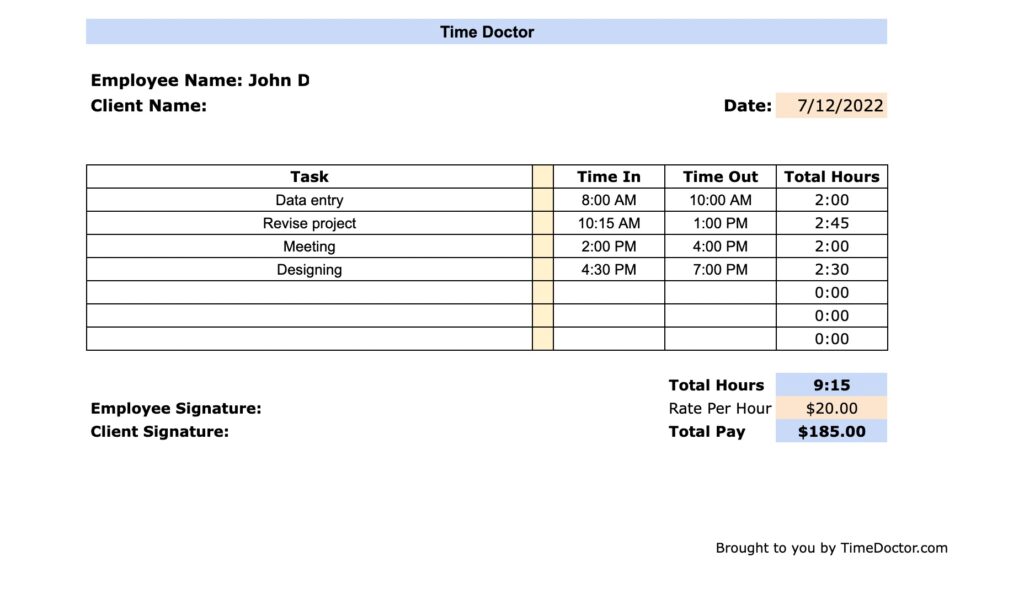
Download daily timesheet template in:
Employees can download this blank timesheet template and fill in their respective details and work hours.
Now let’s look at the other types of timesheet templates.
Other types of timesheet templates
Here are the other six commonly used timesheet templates:
- Weekly timesheet template: A weekly timesheet template includes an employee’s start and end times, sick leaves, overtime, and total work hours for a week. It’s generally used by companies that pay their employees on a weekly basis.
- Bi-weekly timesheet template: A biweekly timesheet template records employee time over two weeks. It includes time entries, time offs, overtime, etc. This employee timesheet template is used by companies that pay their employees bi-weekly.
- Semi-monthly timesheet template: It tracks time entries for an employee for half a month. While semi-monthly employees are paid 24 times a year, bi-weekly employees are paid 26 times.
- Monthly timesheet template: A monthly timesheet template documents employees’ regular hours worked, total hours worked, leaves, overtime, etc. This timesheet template is used by companies that pay employees on a monthly basis.
- Hourly timesheet template: An hourly timesheet template records time entries every hour to pay employees at hourly rates. It includes the date, project names, employee details, hourly rates, and more.
- Project timesheet template: It tracks employees’ total hours worked on a specific project. It helps keep track of labor costs, project progress, and budget.
Let’s now look at the benefits of using these timesheets, especially a daily timesheet.
4 key benefits of using a daily timesheet
Here are the four advantages of using a daily time sheet:
1. Helps manage projects
A daily timesheet can show how long an employee takes to complete a task. You can compare this data with that of other team members to identify whether the employee is productive.
Moreover, you can identify an employee’s strengths from the time they take to complete each task. Accordingly, you can assign employees tasks that they’re good at and improve the overall team performance.
You can also decide if a project would exceed the labor budget and take appropriate action based on the time sheet data.
2. Tracks attendance and overtime issues
Since a daily timesheet will show you employees’ time entries, you can spot when an employee doesn’t start working on time or leaves early.
You can also identify attendance issues like absenteeism and tardiness and ensure employees work for a minimum number of hours every day.
Know the five simple steps to address employee attendance issues.
Let’s say you notice that an employee often comes in late. You can take this up with them and try to resolve the issue so that their productivity isn’t affected.
Likewise, from a daily timesheet, you can easily see when an employee is frequently working overtime hours and is prone to burnout. By reassigning tasks or shifts, you can ensure a fair distribution of work to prevent employees from overworking themselves.
3. Readily accessible and inexpensive
A computer and the Excel software are all you need to access Excel template spreadsheets.
Similarly, employees can use Google Sheets if they have internet access and a computer system.
The formulas and functions in a Google or Excel timesheet calculator are highly customizable. You can also insert tables and charts within an Excel timesheet to keep data organized.
4. Easy to use
Employees may already be well-acquainted with Excel or Google Sheets. As a result, you don’t need to spend excess time or energy coaching them to use it.
You can easily brief them on filling a time sheet in just a short session.
Train your employees with this comprehensive guide on how to fill out a timesheet.
Now let’s look into the disadvantages of using a daily time sheet.
4 major drawbacks of using a daily timesheet
Here are the four limitations of using a daily time sheet:
1. No productivity insights
Although an employee may clock in and out at the right time, you can’t gauge the number of billable hours they were actually productive.
Without this insight, you may not spot an employee’s working style and productivity patterns. This could lead to poor task assignment and scheduling decisions.
For example, employees working overtime need not necessarily be hard working. An employee who frequently works overtime may be doing so to compensate for their long breaks. Whereas other employees, who take short breaks, may not work overtime as they can complete tasks on time.
Daily timesheets won’t tell you about what is happening in real-time.
2. Prone to manual errors
Digital or paper timesheets pass through individual employees, managers, and the HR department before payroll generation. As a result, the chances of human errors are high.
Sometimes, the error could go unnoticed until the invoices are sent to the client, or the payment reaches the employee’s account. In either case, the error would lead to questioning the company’s credibility and decrease trustworthiness. It could also attract legal troubles.
Looking through time entries for such errors is a time-consuming task. Not to mention the extra time and effort it would take to correct the payroll mistakes.
3. Vulnerable to time-theft
Time-theft is the practice in which an employee accepts money for the time they haven’t worked. This practice could be intentional or unintentional, leading to payroll and productivity loss.
Typically time-theft happens when an employee doesn’t account for:
- Late clock-in or early clock-outs.
- Extended lunch breaks.
- Unauthorized overtime hours.
- Buddy-punching (one employee clocks in for another).
With manual time cards, it’s hard to prevent time-theft as there’s no way to differentiate between productive and unproductive hours.
4. Difficult to track intangible tasks
Besides meetings, activities like brainstorming sessions, daily stand-ups, etc., are difficult to measure accurately. You could end up billing a client more or getting paid less.
Sometimes meetings could also deviate from the client’s relevant topic, and you may not record these unproductive hours. This could further lead to incorrect payroll generation.
So how do you overcome the limitations of using a daily timesheet?
Although biometric machines and similar equipment are effective, they’re often costly to install and maintain.
Is there a better way?
Time Doctor: A superior alternative to daily time sheet template
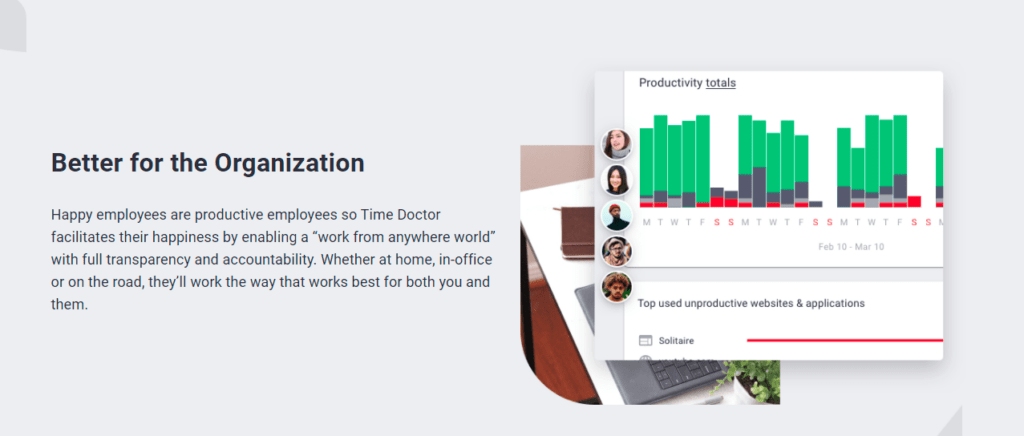
Time Doctor is a time and productivity tracking tool used by small businesses like Thrive Market as well as large enterprises like Ericsson.
Time Doctor tracks every minute they spend on a task or project on a timesheet. It also helps small and large businesses with their payroll needs.
However, that’s not the only thing this time tracking software is capable of.
Let’s take a close look at Time Doctor’s handy features:
A. Silent and interactive time tracking
Time Doctor offers a hassle-free interactive and silent time tracking feature to track employee hours accurately. The tool helps employees prevent manual errors and simplify the time logging process.
The interactive time tracking feature has a simple play/pause icon that lets employees manually ‘Start’ tracking time when they begin a task and ‘Stop’ when they finish or take a break. This gives employees more control over the time they track.
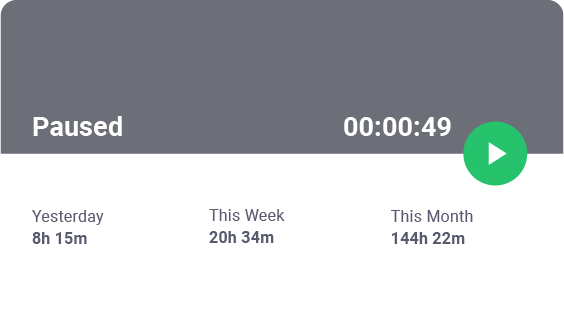
The online timesheet tool also offers an automatic or silent time tracker, which automatically starts logging time as soon as employees turn on their devices. It runs in the background without disrupting your employees’ workflow.
B. Idle time tracking
Time Doctor’s idle time tracking feature shows when an employee is inactive while the timer is running.
The timesheet software detects an employee’s keystrokes and mouse movements to record when there’s no activity. Upon crossing a particular time limit, it nudges the employee to continue working by displaying an idle time pop-up alert.
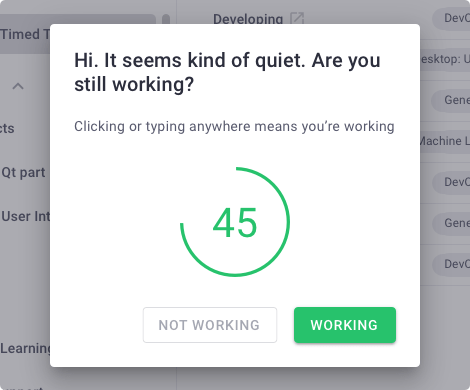
Note: Time Doctor isn’t a keylogger. It only detects whether the employee made any keystrokes and mouse movements.
C. Payroll management
The tool offers a payroll feature that allows you to pay employees directly from popular payment gateways like Gusto, ADP, Paypal, and Wise.
Additionally, it helps you pay employees for a specific pay period using different payment currencies and payment rates.
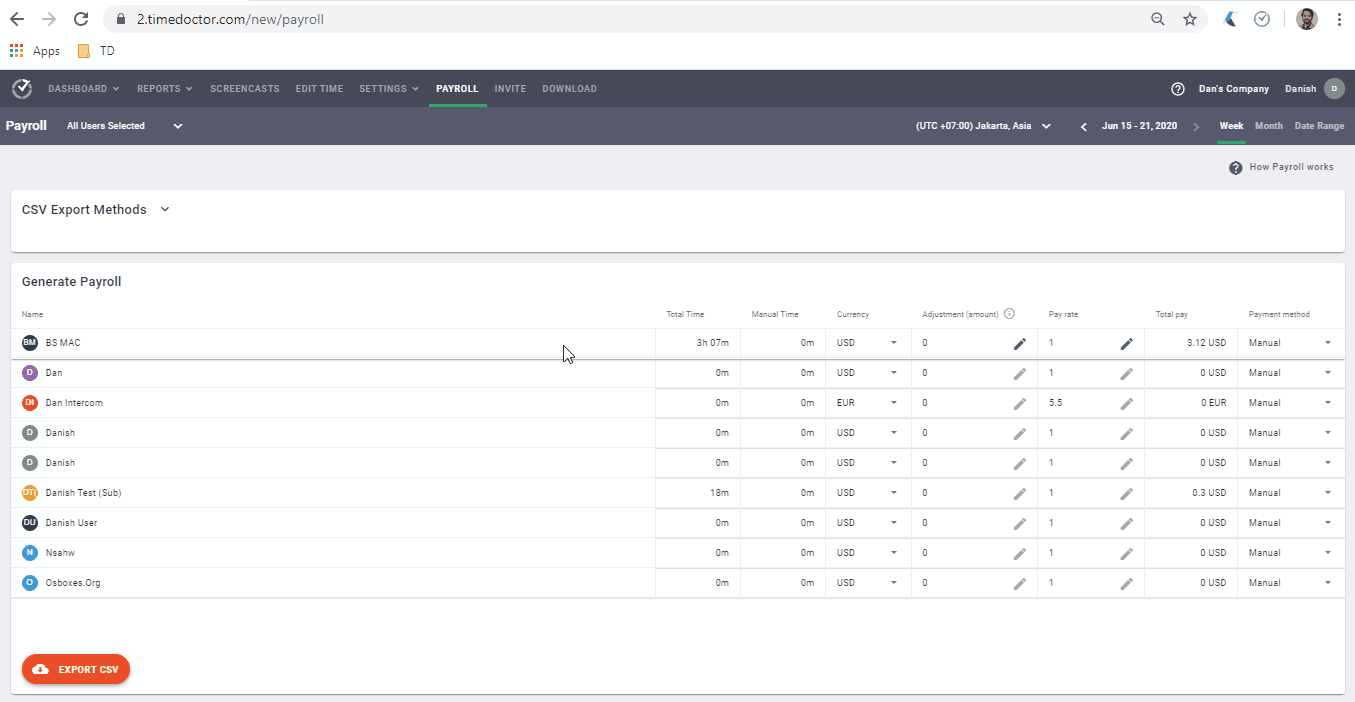
D. Work schedules
The tool offers a work schedule feature with which you can create shifts for employees and track the time they spend during each shift.
This feature helps you record an employee’s attendance status depending on the time they tracked in a day. The tool automatically assigns them ‘Absent,’ ‘Present,’ ‘Late,’ or ‘Partially Absent’ based on their time entries.
For example, it will designate ‘Present’ to an employee who starts the timer on time and ‘Partially Absent’ to an employee who records less than the minimum required hours. Similarly, an employee who doesn’t log time on a particular day will be marked ‘Absent.’
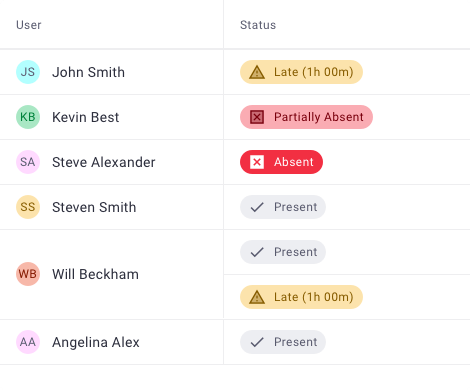
E. Screencasts (Optional)
Time Doctor’s screencasts feature allows you to take screenshots of employees’ monitors at regular time intervals of 3 minutes/15 minutes/30 minutes to spot any unproductive activities.
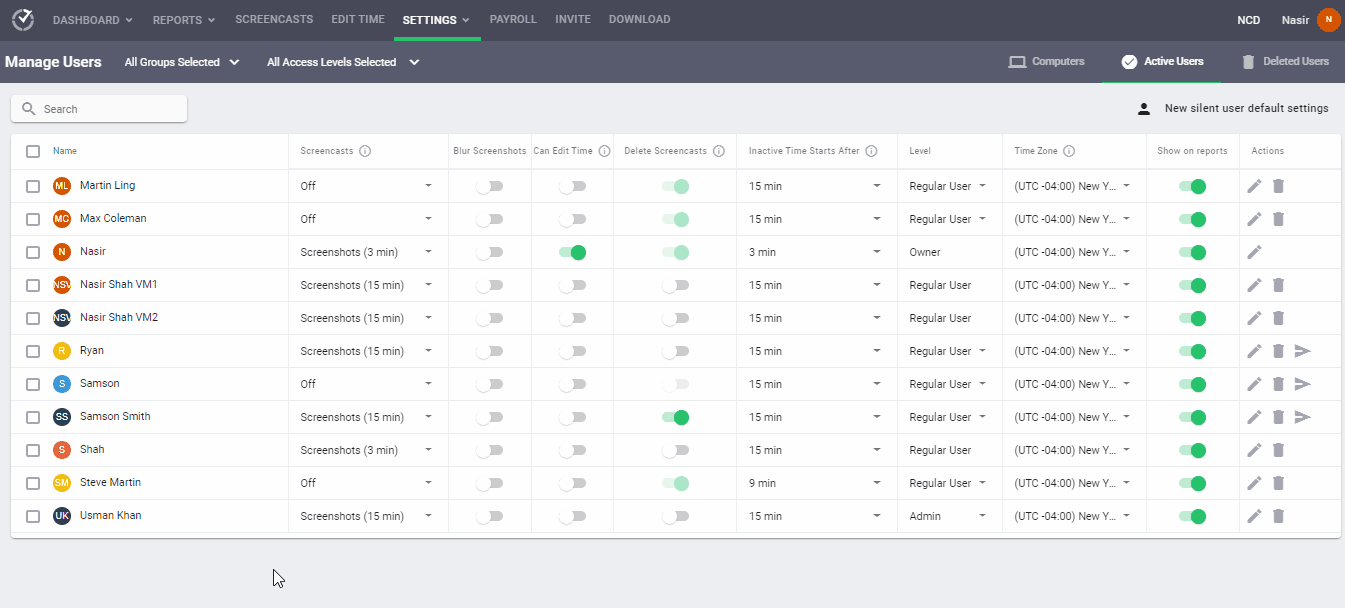
Note: Admins and managers can blur screencasts of an employee or a group of employees to protect their privacy.
F. Project and task management
Time Doctor allows you to create projects and tasks and assign them to a group or employee.
You can also track an employee’s time on a specific task or project.
This feature can help you estimate the average time a similar task or project would take and create more precise project plans in the future.
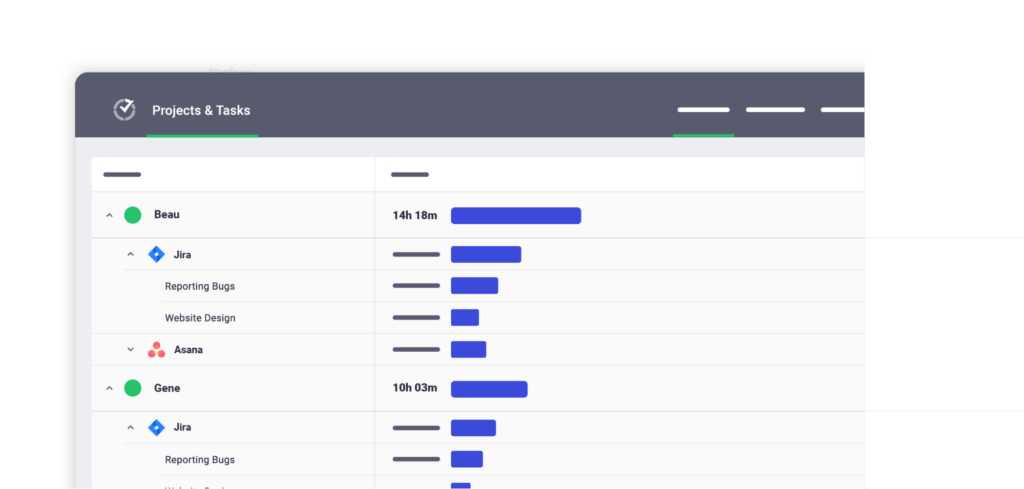
Note: Only admins can assign projects to team members.
G. Productivity ratings
This timesheet software lets you set productivity ratings for each website and app, depending on whether they’re relevant to work.
For example, an employer may want to rate Twitter as ‘Unproductive’ and Google Docs as ‘Productive.’
The different productivity ratings available on Time Doctor are:
- Productive.
- Unproductive.
- Neutral.
- Unrated.
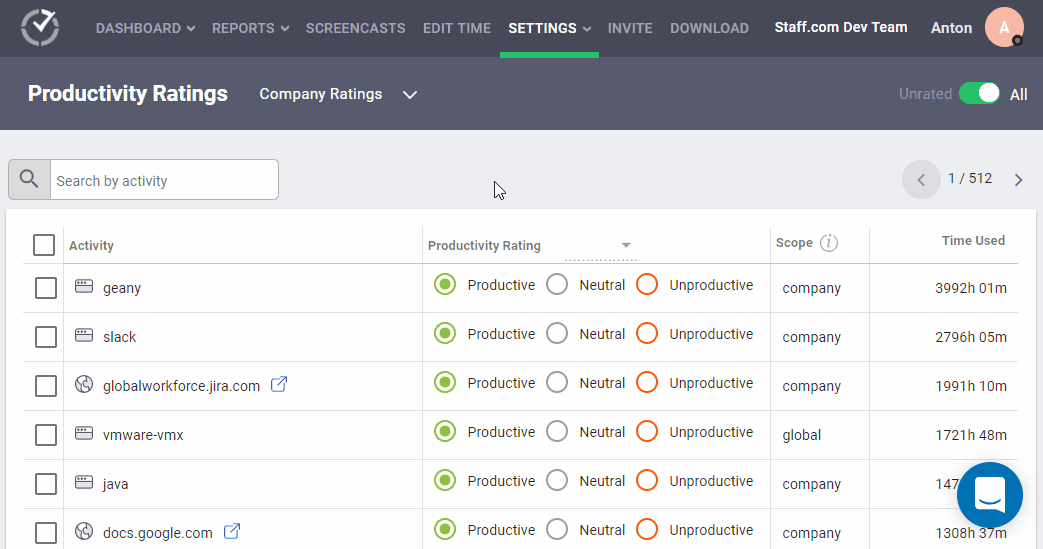
H. Productivity reports
Time Doctor generates several productivity reports based on the time taken to complete tasks or projects. From these reports, you can spot an employee’s productivity patterns and get other work-related insights.
The tool also lets you export reports in CSV, XLS, and PDF format.
Here are the different types of productivity reports available:
- Activity summary report: Lets you see an employee’s active, unproductive, productive, manual, and mobile time for a selected time range.
- Hours tracked report: Shows your team’s work hour data for a specific date range.
- Projects & tasks report: Shows how much time an employee spends on different tasks and projects.
- Custom export report: Lets you customize the information to include in an exported report without downloading individual reports.
- Web & app usage report: Lists the sites and applications employees use during work hours and the time they spend on each of them.
- Timeline report: Shows the time an employee spends working and taking breaks.
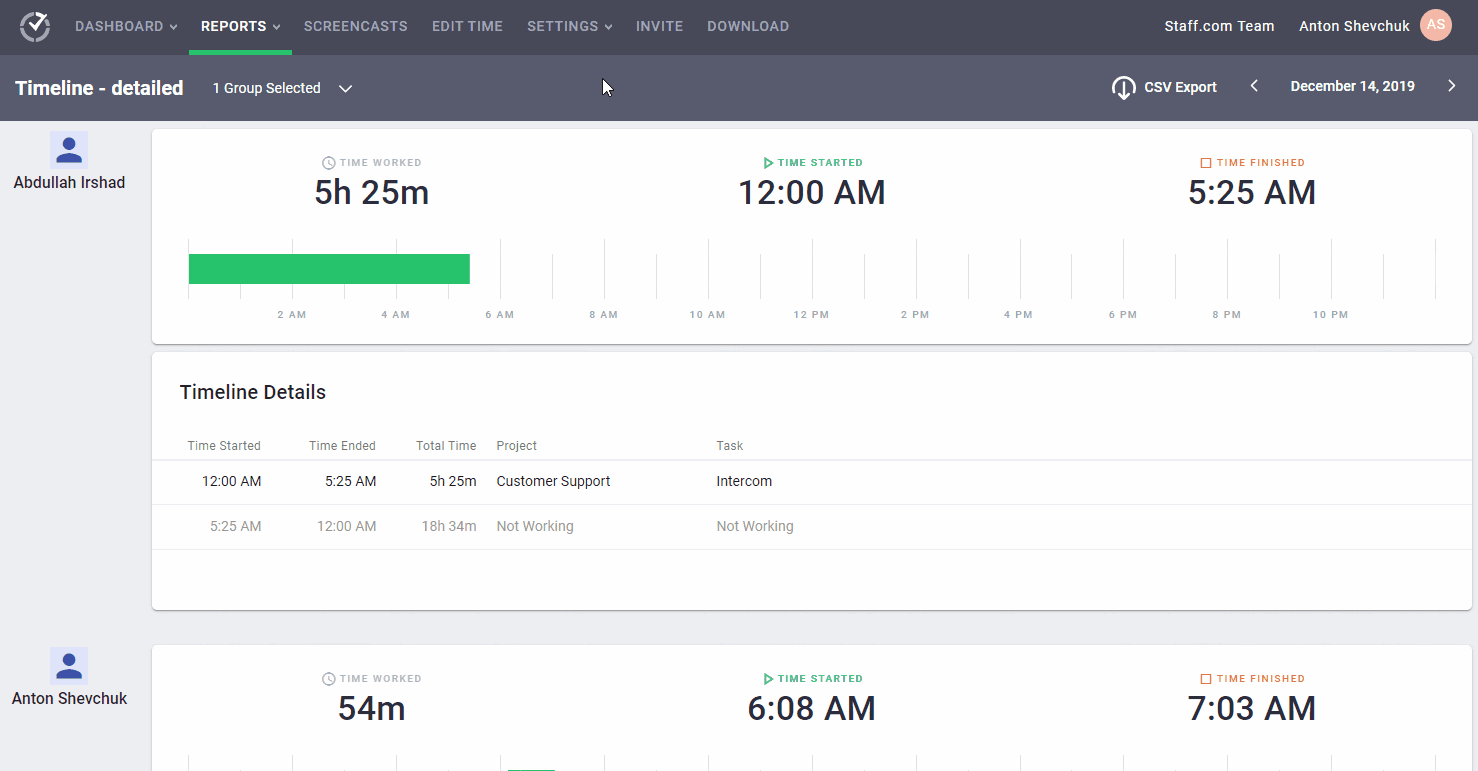
I. Chrome extension
Time Doctor offers a Google Chrome extension that integrates with over 50 other premium tools. Here are some of the tools the software integrates with:
- Project management: Evernote, Zoho Projects, Asana, etc.
- CRM: Hubspot, Pipedrive, Zoho, etc.
- Help Desk: Zendesk, Freshdesk Freshservice, etc.
The tool has a timesheet app for Android devices to track time while on the go. Similarly, it offers a desktop app compatible with Linux, Windows, and Mac.
Check out Time Doctor’s other amazing features here.
Wrapping up
A daily timesheet template can help you track employee work hours and attendance.
However, it’s prone to manual error and time theft and lacks reporting features. This could take up your time and effort and keep your business from growing.
Instead, you can use a time tracking tool, like Time Doctor, that streamlines payroll generation, attendance tracking, and time management.
Sign up with Time Doctor’s 14-day free trial (no credit card required) to generate a daily timesheet automatically and experience its other incredible features!

Carlo Borja is the Content Marketing Manager of Time Doctor, a workforce analytics software for distributed teams. He is a remote work advocate, a father and a coffee junkie.


